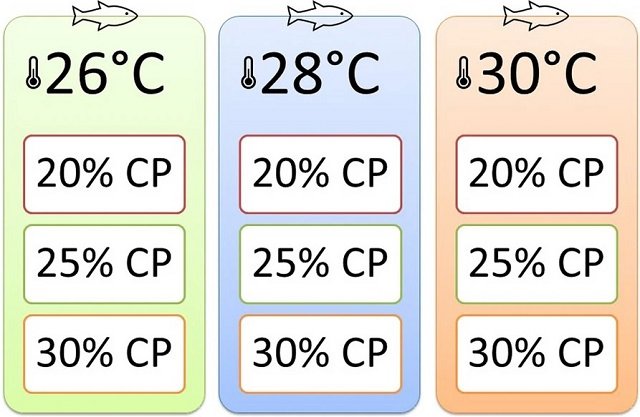
The aquaculture industry is constantly seeking ways to improve fish growth and productivity. However, the looming shadow of climate change poses a significant threat to this sector. Rising water temperatures, changes in salinity, and declining oxygen levels are disrupting aquatic ecosystems and affecting fish health and productivity.
Two critical factors influencing tilapia performance are dietary protein levels and water temperature. A study led by researchers from Kafrelsheikh University (Egypt), Suez University (Egypt), and Mansoura University (Egypt) delved into the complex interaction between these variables to uncover the optimal conditions for the cultivation of Nile tilapia (Oreochromis niloticus).
The Impact of Climate Change on Aquaculture
Nile tilapia, a cornerstone species in aquaculture, is particularly vulnerable to the environmental changes brought about by climate change. Fluctuating water temperatures induce stress, compromise immune systems, and hinder reproductive capabilities. Moreover, these temperature changes affect the entire aquatic food chain, impacting the availability of crucial nutrients for fish.
While higher temperatures can, within certain limits, enhance digestion and nutrient absorption in tilapia, prolonged thermal stress can lead to reduced feed intake, slower growth, and metabolic disturbances.
The Complex Relationship Between Diet and Temperature
Dietary protein is a cornerstone of fish nutrition, influencing growth, metabolism, and immune function. However, protein requirements vary depending on the fish species, growth stage, and environmental conditions. For Nile tilapia, the ideal protein content ranges from 25% to 35%, but this can fluctuate due to factors such as water temperature.
Rising costs of protein ingredients have driven efforts to optimize feed formulations. However, the interaction between diet and temperature remains a complex issue. What works optimally at one temperature range may be less effective at another.
The Experiment: Combinations of Temperature and Protein Levels
The study delves into the intricate relationship between water temperature and dietary protein levels in Nile tilapia. By examining growth rates, feed intake, immune responses, and biochemical markers, the researchers aim to identify the ideal conditions to maximize fish health and productivity while minimizing environmental impacts.
Researchers subjected juvenile Nile tilapia to a controlled environment, manipulating both water temperature (26°C, 28°C, and 30°C) and dietary protein content (20%, 25%, and 30%) over a two-month period.
Key Findings: Water Quality and Fish Physiology
- Water Quality: Higher temperatures, especially at 30°C, led to increased water conductivity and salinity levels, particularly in fish fed higher protein diets. However, ammonia levels were generally lower at warmer temperatures, suggesting a possible trade-off.
- Growth Performance: The optimal combination for growth was found at 28°C with a 25% protein diet. Fish in this group exhibited higher final body weights compared to other conditions.
Physiological Responses
- Hormones: Growth hormone and insulin-like growth factor levels were influenced by both temperature and protein intake. While higher protein diets generally stimulated growth hormone production at 26°C, this effect was less pronounced at 30°C.
- Immune Response: Fish fed higher protein diets, especially at warmer temperatures, showed elevated levels of globulin, mucin-like protein, and lysozyme, indicating enhanced immune function. Antioxidant Status: Antioxidant enzyme activities varied among groups; fish at 30°C and 25% protein exhibited higher levels of superoxide dismutase and catalase.
Optimal Conditions for Tilapia Growth
The results of this study provide valuable insights for optimizing tilapia production. By carefully balancing water temperature and dietary protein levels, aquaculturists can potentially enhance fish growth, improve water quality, and strengthen fish health.
While 28°C with a 25% protein diet proved to be the most outstanding combination in this study, it is essential to consider other factors such as feed cost, market demands, and environmental conditions when making practical decisions.
While higher protein levels (30%) stimulated certain immune responses, as evidenced by increased globulin and lysozyme levels, they did not necessarily translate into better growth performance. Further research is needed to explore the long-term implications of these findings and assess the suitability of these conditions for different tilapia strains and production systems.
Implications for Tilapia Farming
Understanding how climate change interacts with dietary factors is crucial for adapting aquaculture practices to future challenges. By optimizing protein levels in tilapia feed and considering the effects of rising water temperatures, fish farmers can improve the sustainability, profitability, and overall resilience of their operations.
The findings of this study provide valuable insights for tilapia farmers and contribute to ongoing efforts to enhance tilapia resilience to the effects of climate change, such as the use of probiotics in tilapia feed.
Conclusion
While this study makes significant contributions to the field, further research is warranted to explore the long-term effects of different temperature and protein combinations on tilapia reproduction, feed conversion efficiency, and disease resistance. Additionally, it would be beneficial to investigate the economic implications of these findings for aquaculturists.
Open access to the study is provided by the Science, Technology & Innovation Funding Authority (STDF) in cooperation with the Egyptian Knowledge Bank (EKB).
Contact
Seham El-Kassas
Department of Animal Wealth Development, Animal, Poultry and Fish Breeding and Production, Faculty of Veterinary Medicine, Kafrelsheikh University
Kafr El-Sheikh, 33516, Egypt
Email: seham.elkassas@vet.kfs.edu.eg
Reference (open access)
Hamed, S., El-Kassas, S., Abo-Al-Ela, H.G. et al. Interactive effects of water temperature and dietary protein on Nile tilapia: growth, immunity, and physiological health. BMC Vet Res 20, 349 (2024). https://doi.org/10.1186/s12917-024-04198-2
Editor at the digital magazine AquaHoy. He holds a degree in Aquaculture Biology from the National University of Santa (UNS) and a Master’s degree in Science and Innovation Management from the Polytechnic University of Valencia, with postgraduate diplomas in Business Innovation and Innovation Management. He possesses extensive experience in the aquaculture and fisheries sector, having led the Fisheries Innovation Unit of the National Program for Innovation in Fisheries and Aquaculture (PNIPA). He has served as a senior consultant in technology watch, an innovation project formulator and advisor, and a lecturer at UNS. He is a member of the Peruvian College of Biologists and was recognized by the World Aquaculture Society (WAS) in 2016 for his contribution to aquaculture.
